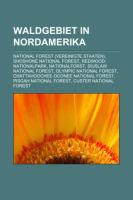| Artikelnummer | 9781159337971 |
|---|---|
| Produkttyp | Buch |
| Preis | 25,50 CHF |
| Verfügbarkeit | Lieferbar |
| Einband | Kartonierter Einband (Kt) |
| Meldetext | Folgt in ca. 5 Arbeitstagen |
| Autor | Quelle: Wikipedia |
| Verlag | Books LLC, Reference Series |
| Weight | 0,0 |
| Erscheinungsjahr | 2011 |
| Seitenangabe | 44 |
| Sprache | ger |
| Anzahl der Bewertungen | 0 |
Waldgebiet in Nordamerika Buchkatalog
Quelle: Wikipedia. Seiten: 43. Kapitel: National Forest (Vereinigte Staaten), Shoshone National Forest, Redwood-Nationalpark, Nationalforst, Siuslaw National Forest, Olympic National Forest, Chattahoochee-Oconee National Forest, Pisgah National Forest, Custer National Forest, Coconino National Forest, Bridger-Teton National Forest, Inyo National Forest, Medicine Bow - Routt National Forest, United States Forest Service, Daniel Boone National Forest, Black Hills National Forest, Muir Woods National Monument, Croatan National Forest, Lolo National Forest, Tongass National Forest, Mount Hood National Forest, Ocala National Forest, White Mountains, Solana State Forest, Uwharrie National Forest, Umatilla National Forest, Shawnee National Forest, Gifford Pinchot National Forest, Caribou-Targhee National Forest, Chugach National Forest, Allegheny National Forest, Malheur National Forest, Apalachicola National Forest, Boise National Forest, San Juan National Forest, Uwharrie Lakes Region, Tanana Valley State Forest, Kaibab National Forest, De Soto National Forest, Kootenai National Forest, Apache-Sitgreaves National Forest, Haines State Forest, Sam Houston National Forest, Manti La Sal National Forest, Coronado National Forest, Flathead National Forest, Uncompahgre National Forest, Gunnison National Forest, Sumter National Forest, White River National Forest, Governor Knowles State Forest, Weiser State Forest, Lewis and Clark National Forest, San Isabel National Forest. Auszug: Der Shoshone National Forest ist einer der ältesten Nationalforste der Vereinigten Staaten und bedeckt eine Fläche von ungefähr 10.000 km² im US-Bundesstaat Wyoming. Als Verwaltungseinheit des Waldbesitzes der Bundesregierung dient der Nationalforst vorrangig der wirtschaftlichen Nutzung, die Forstwirtschaft, Weidenutzung und die Erschließung von Rohstoffen umfasst. Das Waldgebiet gehörte ursprünglich zum Yellowstone Timberland Reservat, das 1891 durch ein von US-Präsident Benjamin Harrison unterzeichnetes Gesetz eingerichtet wurde. Der Nationalforst umfasst heute auch vier Wilderness Areas, die mehr als die Hälfte der bewirtschafteten Fläche als Wildnis vor jedem menschlichen Eingriff schützen. Die einzigartige Vielfalt an Ökosystemen des Shoshone National Forest reicht von Wüsten-Beifuß-Ebenen, über dichte Tannen- und Fichtenwälder bis zu zerklüfteten Berggipfeln. Das Waldgebiet umfasst Teile der drei größeren Gebirgsketten Absaroka Range, Beartooth Mountains und Wind River Range. Die westliche Grenze wird vom Yellowstone-Nationalpark gebildet. Südlich von Yellowstone teilt die Kontinentale Wasserscheide den Forst vom westlich benachbarten Bridger-Teton National Forest. Die Ostgrenze umfasst Privatgrundstücke, vom US-Bureau of Land Management verwaltetes Land und die Wind River Indian Reservation der Shoshone und Arapaho-Indianer. Die Grenze zum Norden bildet der Custer National Forest entlang der Grenze zu Montana. Südlich des Shoshone National Forest verläuft der Oregon Trail mit dem South Pass, den die Einwanderer aus dem 19. Jahrhundert nutzten, um die schroffe Landschaft des Forstes zu passieren. Der Nationalforst ist Teil des Größeren Yellowstone-Ökosystems, das als zusammenhängender Naturraum schätzungsweise umfasst. Shoshone National Forest, Lagekarte Gannett Peak ist der höchste Berg in Wyoming und im NationalforstDie Höhe des Waldes reicht von bei Cody bis auf der Spitze des Gannett Peak, ein Höhenunterschied von über . Die drei im Wald vorkommenden Hau
25,50 CHF
Lieferbar


Dieser Artikel hat noch keine Bewertungen.